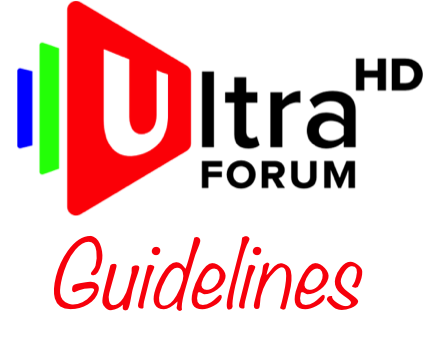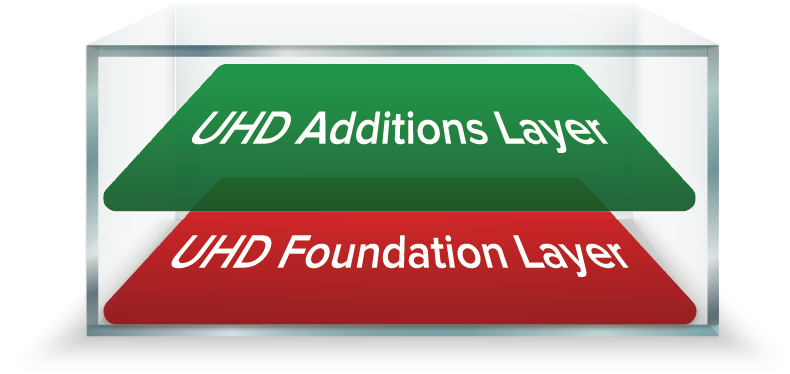
With the NAB Show this year, we hope to return to the normal pace of new developments in the TV business. Despite COVID, UHD has continued to grow both in the number of channels and services delivering UHD video (as you can see in our ever-growing Service Tracker) and in the development of new technologies and production methods.
The UltraHD Guidelines working group has continued to add to the body of knowledge that started in 2015 with the first version of the Guidelines. In that release, the UltraHD Forum set a baseline for UHD services, called the Foundation technologies:
- Video: 2160p60 or 1080p60 with High Dynamic Range (HDR). HEVC encoding.
- HDR: PQ10 (using the PQ curve with 10 bits) or HLG10 (Hybrid Log-Gamma with 10 bits).
- Color: Use of wide color gamuts (greater than ITU BT.709) in a BT.2020 container.
- Audio: 5.1 or greater, including channel-based immersive audio.
With version 2.0, released in May 2019, the Guidelines incorporated alongside the Foundation technologies Additional UHD technologies. These technologies built upon and provided improvements to the Foundation UHD technologies. Examples of Additional technologies are:
- Dynamic HDR metadata, including Dolby Vision, SL-HDR1 and SL-HDR2
- Immersive Object-based audio such as AC-4, MPEG-H, DTS-UHD
- Content-Aware Encoding (CAE)
- High Framerate (HFR), greater than 60 fps
In addition, v2 of the Guidelines, as a set of annexes, we documented real-world case studies of UHD productions, examining the production and distribution methods and which technologies were in use. As the Guidelines grew, we added additional technologies and techniques that were just emerging and had yet to gain wide adoption. Today the Annexes include:
ACES color management workflow
AVS2 video encoding
IP based production workflows,
ATSC 3.0, DVB-T2 UHD, and Brazil broadcast standards for UHD
Some sections address how these Additional UHD technologies can be used for production and distribution. An extensive list of reference standards (over 100), 46 Tables, and 162 Figures make the Guidelines a comprehensive reference on UHD technologies.
Let’s look at the last two versions of the Guidelines and drill down on the new additions to the Guidelines.
HDR. In v2.5, we expanded the HDR section to compare SDR (Standard Dynamic Range) and HDR, including the practical range of light values for cameras, displays, and the human visual system. Background on how human vision adapts to changes in light levels and the impact of HDR on the viewer are explained.

OTT. Given the rapid increase of OTT (Over the Top) services, we added a section on best practices for OTT deployment for UHD to the Guidelines. We provided information on DASH-HLS and Adaptive Bitrate Streaming (ABR).
AVS3. In the AVS2 Annex, we updated the section to provide information on the release of AVS3 video encoding, including an overview of the coding framework and references to this evolving standard.
ATSC 3.0. We continue to track the adoption of ATSC 3.0 technology in Korea and the US.
ST 2110. Added an annex describing the use of Video over IP for UHD production. This Annex has been expanded in v2.6 to include other Video over IP technologies such as ST 2022, NDI, Zixi, and SRT. Note that at the UltraHD Forum’s NAB booth (W6132) in Futures Park, there will be a working example of UHD video over IP using ST 2110.
Single-Stream Live Production of SDR/HDR. NBCUniversal has contributed a detailed description of their production workflow for producing live events using a single-stream workflow to output an HD/SDR program and a UHD/HDR program. They describe their approach using HLG as a production format, including reference 3D LUTs, to go between
- HDR and SDR,
- SDR to HDR,
- HLG to PQ.
The guidelines are a dynamic document linked to the NBCUniversal GitHub site with the latest technical information.
Real-World Deployments. The production of the Tokyo Olympics in UHD is described in v2.5, using both AC-4 and MPEG-H immersive audio. In v2.6, additional descriptions of NGA real-world deployments, including AC-4 use during Euro 2020 Football (TVP, Polish TV), French Open Tennis (France TV over DVB-T2), as well as MPEG-H, use in Rock in Rio (TV Globo Brazil), Eurovision Song Contests, 2018 (RTP, Portugal) and 2019 (EBU). Rebe Amazonica launched a 24/7 service on ISDB-Tb using MPEG-H. These descriptions included detailed information on production techniques as well as distribution methods.
Brazil. Recently Brazil has selected a framework for their next-generation DTTV (Digital Terrestrial TV) technology, including elements of ATSC 3.0 and technologies documented in the UltraHD Forum’s Guidelines, including SL-HDR2, SL-HDR1, MPEG-H, with optional use for OTT of HEVC, AC-4, and DASH-HLS.
NGA Workflows. In v2.6, the latest Annex is devoted to documenting the workflows that enable immersive and personalized audio. Examples are given as well as guidance on how to produce immersive and personalized audio programs and how to encode and distribute using AC-4 or MPEG-H audio coding technologies.
Conversion between formats. The Guidelines, starting in v2.5 and added to in v2.6, is a detailed discussion of the challenge of converting HD SDR with Rec 709 color to HDR with Wide Color (Rec 2020). There are methods of measuring color accuracy with examples of problems that can happen when using LUTs that are not correct or precise enough. Discussion of the interoperability between PQ and HLG video and the use of defined reference points for peak white as defined in ITU Rec BT. 2100. An explanation of ICtCp and the use of ΔE-ITP color error metrics are included.
The Guidelines are available on the UltraHD Forum website at: https://ultrahdforum.org/guidelines/
